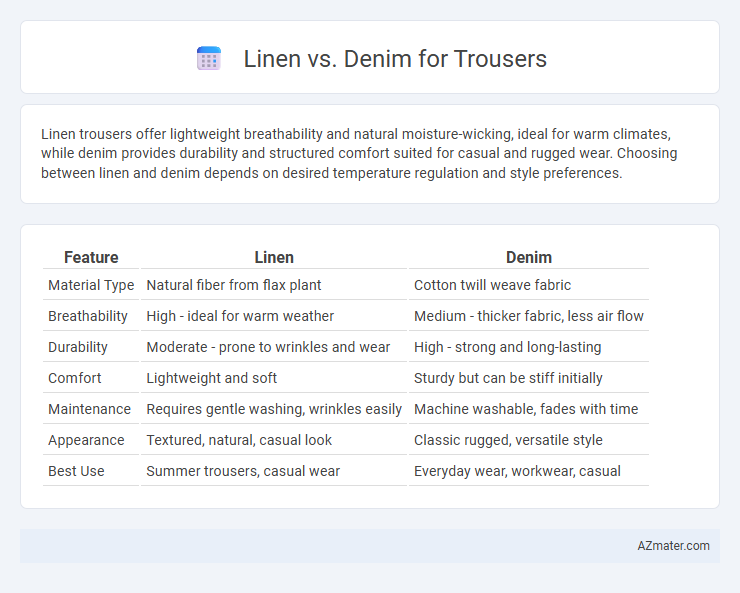Linen trousers offer lightweight breathability and natural moisture-wicking, ideal for warm climates, while denim provides durability and structured comfort suited for casual and rugged wear. Choosing between linen and denim depends on desired temperature regulation and style preferences.
Table of Comparison
| Feature | Linen | Denim |
|---|---|---|
| Material Type | Natural fiber from flax plant | Cotton twill weave fabric |
| Breathability | High - ideal for warm weather | Medium - thicker fabric, less air flow |
| Durability | Moderate - prone to wrinkles and wear | High - strong and long-lasting |
| Comfort | Lightweight and soft | Sturdy but can be stiff initially |
| Maintenance | Requires gentle washing, wrinkles easily | Machine washable, fades with time |
| Appearance | Textured, natural, casual look | Classic rugged, versatile style |
| Best Use | Summer trousers, casual wear | Everyday wear, workwear, casual |
Introduction: Linen vs Denim Trousers
Linen trousers offer exceptional breathability and lightweight comfort, making them ideal for warm weather and casual settings. Denim trousers provide durability and a classic rugged style, suited for everyday wear and more structured outfits. Choosing between linen and denim depends on climate preference, desired texture, and versatility in styling.
Material Overview: Linen and Denim Explained
Linen trousers are crafted from fibers derived from the flax plant, offering lightweight breathability and exceptional moisture-wicking properties ideal for warm climates. Denim, made from tightly woven cotton twill fabric, provides durability and a thicker texture suitable for casual and rugged wear. Both materials influence the comfort, appearance, and functionality of trousers, with linen emphasizing coolness and softness while denim delivers strength and a structured fit.
Comfort and Breathability Comparison
Linen trousers offer superior comfort and breathability due to their natural fiber construction, which allows maximum airflow and moisture absorption, making them ideal for warm weather. Denim, while durable and sturdy, tends to be heavier and less breathable, which can result in less comfort during hot or humid conditions. Choosing linen over denim enhances comfort by reducing heat retention and promoting ventilation, essential for all-day wear in warmer climates.
Durability: Which Lasts Longer?
Denim trousers typically offer greater durability due to their tightly woven cotton twill fabric, which resists wear and tear better than linen. Linen, while breathable and lightweight, tends to weaken and develop wear spots more quickly with frequent use and washing. For long-lasting trousers suitable for rugged or heavy-duty use, denim remains the preferred choice over linen.
Suitability for Different Climates
Linen trousers excel in hot and humid climates due to their lightweight, breathable fibers that allow air circulation and moisture-wicking, keeping the wearer cool and dry. Denim trousers, made from thicker cotton twill fabric, provide better insulation and durability, making them more suitable for cooler or transitional weather. Choosing between linen and denim for trousers depends largely on the climate, favoring linen for summer heat and denim for mild to cold conditions.
Style Versatility and Fashion Appeal
Linen trousers offer a lightweight, breathable option that exudes effortless elegance, ideal for warm weather and casual to semi-formal occasions. Denim trousers provide a rugged, timeless look with superior durability, making them versatile for casual wear and street-style fashion. Both fabrics maintain strong fashion appeal, with linen favoring a soft, relaxed silhouette and denim delivering a structured, edgy vibe.
Maintenance and Care Requirements
Linen trousers require gentle washing in cold water and air drying to prevent shrinking and maintain fabric integrity, while denim trousers are more durable and can withstand regular machine washing but benefit from turning inside out to preserve color. Linen is prone to wrinkles and requires frequent ironing or steaming, whereas denim naturally softens with wear and demands less frequent pressing. Proper care for both fabrics enhances longevity, but linen demands more delicate handling compared to the rugged resilience of denim.
Price and Value Considerations
Linen trousers typically come at a moderate price point, valued for their breathability and lightweight comfort, making them ideal for warm climates but prone to wrinkles. Denim trousers often command a higher price due to durability and timeless style, offering greater longevity and resistance to wear and tear. Choosing between linen and denim depends on budget priorities and lifestyle, balancing initial cost with long-term value and intended use.
Best Occasions for Linen vs Denim Trousers
Linen trousers are ideal for warm weather occasions such as beach weddings, summer parties, and casual outdoor events due to their lightweight, breathable fabric. Denim trousers suit casual settings like weekend outings, concerts, and daytime errands, offering durability and a rugged style. Choosing between linen and denim depends on the event's formality and climate, with linen best for relaxed, hot-weather environments and denim for versatile, everyday wear.
Final Verdict: Choosing the Right Trouser Material
Linen trousers offer exceptional breathability and lightweight comfort, making them ideal for warm weather and casual settings, while denim provides durability and structure suitable for everyday wear and rugged activities. The choice between linen and denim depends on climate, intended use, and desired aesthetic; linen prioritizes softness and airflow, whereas denim excels in longevity and a classic look. Selecting the right trouser material balances comfort, practicality, and style preferences to meet specific lifestyle needs.

Infographic: Linen vs Denim for Trouser
 azmater.com
azmater.com